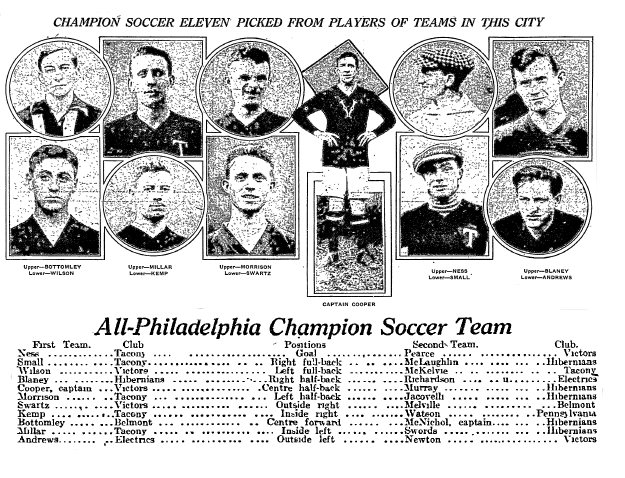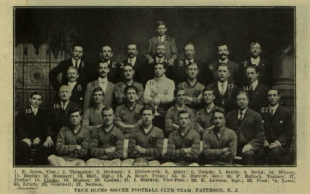Featured image: Paterson Trues Blues, 1913
2013 is the centennial of the US Soccer Federation. Our series looking back at the Philadelphia soccer scene one hundred years ago continues.
American Cup final: Tacony FC vs. Paterson True Blues
On April 12, 1913, Tacony met Paterson True Blues in the American Cup final. The game, the first American Cup final to take place in Philadelphia, would be played at Second and Allegheny at the home grounds of Tacony’s biggest Philadelphia rival, Hibernians.
Philadelphia’s soccer boosters had worked hard to have the final played in Philadelphia and had promised the tournament backers, the American Football Association, a big crowd. Then on Friday, April 11, the rain began. It was raining heavily when the Saturday game began, the Inquirer reporting on April 13 that only “1000 odd spectators who had braved the elements” were on hand. The Inquirer report continued, “Never before to the knowledge of the writer has the final been contested in such adverse conditions. The ground was in fairly good shape at the beginning of the game, but it chopped up considerably and made the footing bad for the players, who, nevertheless, did not seem to mind the conditions, and in consequence play was fast and exciting all during the ninety minutes.” By the end of gameday on Saturday, two inches of rain had fallen.
Some 250 fans had traveled by train from Paterson to support the True Blues. Founded in 1887, the True Blues were on of the storied teams of American soccer history. They were making their sixth American Cup final appearance, winning the tournament in 1896 and 1909.
Tacony, winners of the 1910 American Cup, were the aggressors from the start of play and only eight minutes after the opening whistle, Bobby Morrison put the local side on the board with what the Inquirer described as “a peach” of a goal. While the True Blue fought back, Owens would make it 2–0 for Tacony before the half.
Twenty-five minutes after the resumption of play, the True Blues center halfback Clark pulled a goal back for the visitors. The two sides battled furiously with Tacony applying pressure in the waning minutes on the True Blues goal and looking to put the game out of reach. Then, with three minutes left, the True Blues sprang a counter attack that saw them carry the ball the length of the field before outside left Nelson leveled the score with “a perfect shot.”
The Inquirer concluded, “The Jerseymen outstayed the locals, the latter probably putting all of their reserve force into power when they tallied their two goals in the initial period, thereby having none left in the final minutes when the Blues seemed to gain renewed strength.” The Inquirer concluded “it was a regular typical cup tie match where none of the players asked any quarter, everyone playing a the top of his form and striving his utmost to help his team to win the much coveted trophy which carries with it the championship of America.”
An Inquirer report on April 14 bluntly said that, given the conditions and constant rain, the game should never have been played. The local organizers would have waited “until the first clear Saturday rather than have the spectators standing on a wet field, soaked to their skins, watching twenty-two players battling for the championship of America under conditions that were better suited for water polo.”
The two teams would have a week to rest and prepare for the replay, which would take place on the same grounds on April 19.
Eastern PA & District soccer association formed
Six days after the founding of the United States of America Foot Ball Association, known today as the US Soccer Federation, the Eastern Pennsylvania and District soccer association was founded. The motivation for its founding was the same as that which was behind the founding of the USFA: to bring order to the multiplicity of leagues in the area and so create harmony for the better promotion of the game.
A report in the Inquirer on April 14 noted that the most important thing the new association would have to do from the start would be to elect officers who enjoyed the respect of those they would govern, men who harbored no sympathies for a particular team. Only then would the association be able to “eliminate all those petty grievances that have been very conspicuous in the past. Unless the men elected to the governing board are satisfactory to all involved, and their status above question as regards their neutrality, those in charge of the new association might just as well disband right now.”
All-Philadelphia team named
On April 13, 1913, the Philadelphia Inquirer named its “All-Philadelphia Champion Team,” its first and second team picks of the best players in the city. Players from the city’s professional Pennsylvania League dominated both lists with only two players, Bottomley from Belmont in the Cricket club League and Andrews from the Philadelphia Electrics of the American League, representing non Pennsylvania League players on the first team. Interestingly, no players from Bethlehem, winners of the Allied American League championship, or Boys’ Club, champions of the American League, made either list. Tacony players dominated the first team despite the club finishing third in the Pennsylvania League.
 Odds and ends
Odds and ends
The Inquirer reported on April 13 that the Belmont Club, who had won the Cricket League title that season and whose grounds in West Philadelphia had been bought by the city to be turned into a public park, had found a new home in Merchantville, New Jersey. Belmont had hosted the first international played in Philadelphia in 1901 and played a big part in helping grow the game in Philadelphia in the first decade of the 20th Century.
In Intercollegiate Soccer League play, University of Pennsylvania defeated Cornell 4-2. The match, originally scheduled to be played in Moorestown, New Jersey, was at the last minute moved to Penn’s Settlement field. The Inquirer reported on April 13 that with the field in poor shape, “and on one end of it…a great deal of water,” it was agreed that each half would be only 35 minutes long.


That the True Blues were able to reach the final at all is remarkable considering that Paterson was in the midst of a strike at its silk mills that lasted six months and resulted in the arrest of more than 1,800 strikers.
Thank you for the historical context, that is very interesting to learn.